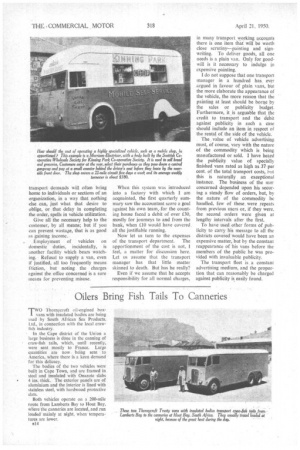INVISIBLE INCOME
Page 47

Page 48

If you've noticed an error in this article please click here to report it so we can fix it.
from transport fleets
By Ashley Taylor, A.I.R.T.E.
IN consequence of influence which will be well known to the majority of readers, many traders have lately been extending their fleets and starting new ones. Naturally, costs are first carefully examined.
In most business houses there is inter-departmental competition in the matter of the expenses allocated to the various sections of the organization. the accountant generally being the final arbiter. As a result of his training, he is usually a fairminded man and can examine finan cial matters objectively. However, he can usually do this only on the weight of evidence which is placed before him, and it must be admitted that some extremely able industrial transport managers are not so strong when it comes to the theory of traffic administration.
One ancillary user's fleet with which I am acquainted is the subject of the most rigorous financial record
ing. Every penny that is spent is debited against the department, together with agreed apportionments for overhead charges, right down to percentages of the loss on the canteen and on the subscriptions to magazines circulating among the transport staff. There is another side to the picture, however, for the statistical men of the concern in question are the transport manager finds himself faced with the task of deciding upon priorities when the fleet is not equal to all the demands or when he Is compelled to put forward requests for the acquisition of additional vehicles, Ordinarily, if he neglects to do these things, chaos is liable to ensue; if he does do them—and especially when he explains why more vans are wanted—internal dissensions are apt to arise. The expression in pounds, shillings and pence of the cost of
transport demands will often bring home to individuals or sections of an organization, in a way that nothing else can, just what that desire to oblige, or that delay in completing the order, spells in vehicle utilization.
Give all the necessary help to the customer, by all means; but if you can prevent wastage, that is as good as gaining income.
Employment of vehicles on domestic duties, incidentally, is another facility which bears watching. Refusal to supply a van, even if justified, all too frequently means friction, but noting the charges against the office concerned is a sure means for preventing misuse. When this system was introduced into a factory with which I am acquainted, the first quarterly summary saw the accountant score a goal against his own team,-for the counting house faced a debit of over £30, mostly for journeys to and from the bank, when £10 would have covered , all the justifiable running.
Now let us turn to the expenses of the transport department. The apportionment of the cost is not, I feel, a matter for discussion here. Let us assume that the transport manager has that little matter skinned to death. But has he really?
Even if we assume that he accepts responsibility for all normal charges,
in many transport .working kiccomits there is one item that will be worth close scrutiny—painting and signwriting. To deliver goods, all one needs is a plain van. Only for goodwill is it necessary to indulge in expensive painting.
I do not suppose that one transport manager in a hundred has ever argued in favour of plain vans, but the more elaborate the appearance of the vehicle, the more reason that the painting at least should be borne by the sales or publicity budget. Furthermore, kis arguable that the credit to transport and the debit against publicity in such a case should include an item in respect of the rental of the side of the vehicle.
• The. value of vehicle advertising must, of course, vary with the nature of the commodity which is being manufactured or sold. I have heard the publicity value of specially finished vans rated as high as 37. per cent. of the total transport costs, but this is naturally an exceptional instance.. The business of the user concerned depended upon his securing a steady flow of orders, but, by the nature of the commodity he handled, few of these• were .repeats from previous users or, if they were, the second orders were given at lengthy intervals after the first.
To have used other forms of publicity to carry his message to all the districts covered would have been an expensive matter, but by the constant reappearance of his vans before the members of the public he was provided with invaluable publicity.
The transport fleet is a constant advertising medium, and the proportion that can reasonably be charged against publicity is easily found.




















































































